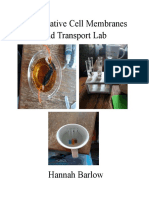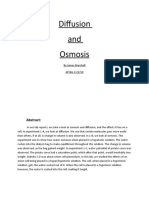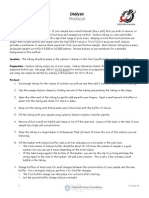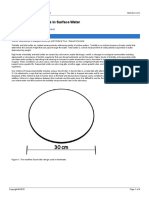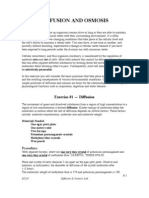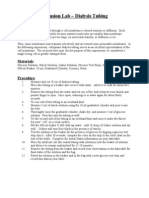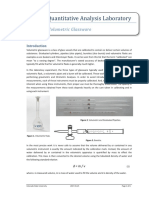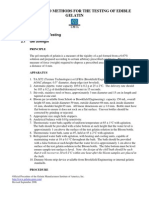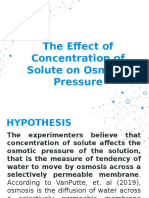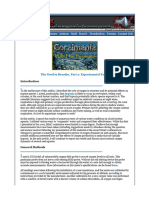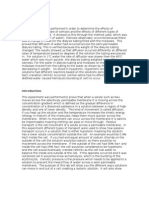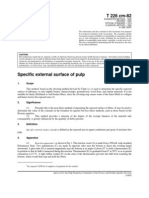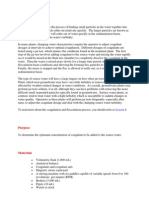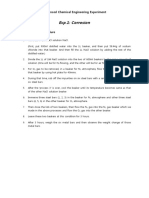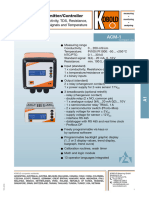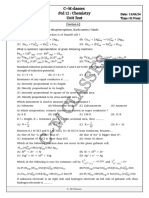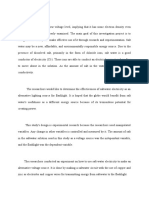Exp 7. Liquid Diffusion Coefficient
Exp 7. Liquid Diffusion Coefficient
Uploaded by
김승민Copyright:
Available Formats
Exp 7. Liquid Diffusion Coefficient
Exp 7. Liquid Diffusion Coefficient
Uploaded by
김승민Original Title
Copyright
Available Formats
Share this document
Did you find this document useful?
Is this content inappropriate?
Copyright:
Available Formats
Exp 7. Liquid Diffusion Coefficient
Exp 7. Liquid Diffusion Coefficient
Uploaded by
김승민Copyright:
Available Formats
<Liquid diffusion coefficient experimental>
Objective
To determine the Diffusion Coefficient as the concentrations of NaCl solution.
Method
As diffusion of the solute occurs, the concentration within the larger volume increases and is
monitored with a conductivity meter.
The mixture is continuously agitated with a magnetic stirrer to ensure uniform concentration within the
bulk liquid.
Whilst the apparatus maybe used with any required aqueous system, for introductory studies, 1.0M or
0.1M solutions of Sodium Chloride are recommended, for which conductivity data is provided.
1. Make up a 1M solution of NaCl by dissolving 58.44 gm of the salt into 1.0 litres of water. (also,
0.1M and,0.5M; total 3 solutions)
2. Fill the acrylic vessel with 1 litre of distilled or deionised water using the measuring jug supplied.
3. Locate the lid (with the glass diffusion cell fitted) on top of the vessel but locate it eccentrically so
that it does not locate in the recess and the lid is 5 mm above its normal operating position.
4. Steady the lid on top of the vessel and check that the top of the honeycomb of capillaries is flush
with the surface of the water. If necessary adjust the height of the glass diffusion cell by unscrewing
the gland nut that secures it.
5. Place the stirrer bar into the bottom of the acrylic vessel and locate the vessel on top of the battery
operated stirrer.
6. Connect the conductivity electrode to the socket at the top of the conductivity meter.
7. Set the range switch to 199.9 μS on the conductivity meter and switch the meter on by pressing
the POWER button.
8. Fill the glass diffusion cell with 1M NaCl using the syringe supplied. Ensure that the glass hook
and plastic honeycomb are filled with the solution with no air bubbles trapped.
9. This can be achieved by immersing the hook into the solution while forcing liquid through the
capillaries using the syringe filled with the same solution
10. Wipe off any excess solution from the outside of the cell and the tops of the capillaries using filter
paper or similar absorbent material but take care not to suck the salt solution through the capillaries. It
is important to adjust the level inside the cell so that the free surface is adjacent to the collar on the
vertical limb of the cell i.e. 5 mm above the tops of the capillaries.
11. Check the conductivity meter every 1 minute.
12. This ensures that the salt solution is not disturbed when the cell is immersed 5 mm below the
surface of the water in the vessel. Do not place the cell into the vessel until instructed.
You might also like
- Comparative Cell Membranes and Transport Lab ReportDocument10 pagesComparative Cell Membranes and Transport Lab Reportapi-314520592100% (4)
- Folymer Chemistry An Introduction 3rd Ed. SolutionDocument80 pagesFolymer Chemistry An Introduction 3rd Ed. Solution김승민No ratings yet
- AGS011-04 Painting and Protective CoatingsDocument30 pagesAGS011-04 Painting and Protective CoatingsJose MachadoNo ratings yet
- Exp 4Document4 pagesExp 4Faith de Leon ♥0% (1)
- Exp 3 - Determination of Avogadro's NumberDocument3 pagesExp 3 - Determination of Avogadro's NumberMay LeeNo ratings yet
- Advantage Mud Manual PDFDocument408 pagesAdvantage Mud Manual PDFEduardo Guajardo100% (2)
- HSC Chemistry PracticalsDocument10 pagesHSC Chemistry PracticalsRishi Máran50% (4)
- Activity No. 1 ProceduresDocument3 pagesActivity No. 1 ProceduresHyacinth PerezNo ratings yet
- Mass Lab DiffusionDocument12 pagesMass Lab DiffusionNegese TeklearegayNo ratings yet
- Astm D4006-16Document5 pagesAstm D4006-16Ahmed ElsharkawyNo ratings yet
- Laboratory Experiment 1. Calibration of Volumetric GlasswareDocument3 pagesLaboratory Experiment 1. Calibration of Volumetric GlasswareArif AshrafNo ratings yet
- Act 8 ProcedureDocument9 pagesAct 8 Proceduretep45No ratings yet
- Laboratory Manual MeteorologyDocument67 pagesLaboratory Manual MeteorologyMELANIE ANTOLINNo ratings yet
- Act.03 Cell Membrane Transport Part 1Document5 pagesAct.03 Cell Membrane Transport Part 1CatNo ratings yet
- Diffusion and Osmosis: AbstractDocument10 pagesDiffusion and Osmosis: AbstractJames MarshallNo ratings yet
- Dialysis ProtocolDocument1 pageDialysis ProtocolSatyaki MajumdarNo ratings yet
- Burette and Pipet CalDocument3 pagesBurette and Pipet CalBahgia MinhatNo ratings yet
- Laboratory (Corrections) Revised 2019 K.MDocument32 pagesLaboratory (Corrections) Revised 2019 K.Mmusiccrazikm .indiaNo ratings yet
- Jove Protocol 10015 Turbidity and Total Solids in Surface Water1 PDFDocument4 pagesJove Protocol 10015 Turbidity and Total Solids in Surface Water1 PDFDaniela Alvarez LaraNo ratings yet
- Chem Note 2Document7 pagesChem Note 2Gee BandongNo ratings yet
- Erythrocyte Fragility TestDocument2 pagesErythrocyte Fragility Testkiedd_04100% (4)
- Diff Osmosis Lab Sp11Document8 pagesDiff Osmosis Lab Sp11Kelly TrainorNo ratings yet
- Act03 Membrane Transport DiscussionDocument7 pagesAct03 Membrane Transport DiscussionPaula Nicole AlanoNo ratings yet
- Activity 5. TonicityDocument4 pagesActivity 5. TonicityBrian James BurtonNo ratings yet
- Cole-Parmer Ammonia Gas-Sensing Electrode Instruction Manual General InstructionsDocument23 pagesCole-Parmer Ammonia Gas-Sensing Electrode Instruction Manual General InstructionsHương PhạmNo ratings yet
- Jar TestingDocument2 pagesJar TestingBalRam DhimanNo ratings yet
- Ion Chromatography Procedure: Last Updated: 5.29.13Document6 pagesIon Chromatography Procedure: Last Updated: 5.29.13sofvelNo ratings yet
- (Cytiva) Iou Exchange Media. Instroction For UseDocument16 pages(Cytiva) Iou Exchange Media. Instroction For Usebiwetel320No ratings yet
- Dialysis Tube LabDocument2 pagesDialysis Tube LabJosieA_YNo ratings yet
- Sds Page: Procedure: 1. Assembling The Glass PlateDocument3 pagesSds Page: Procedure: 1. Assembling The Glass PlateSushmita ChaudharyNo ratings yet
- Roquest Jar Test Procedure: Table 1: Determining The ML Dilution of RoquestDocument1 pageRoquest Jar Test Procedure: Table 1: Determining The ML Dilution of RoquestAqey QeyyNo ratings yet
- Red Blood Cell FragilityDocument3 pagesRed Blood Cell Fragilitybotmot21_339656833No ratings yet
- Calibrating A PipetDocument1 pageCalibrating A PipetdbzoNo ratings yet
- AICE Biology Osmosis Lab: Plasmolysis in Plant Tissue: BackgroundDocument3 pagesAICE Biology Osmosis Lab: Plasmolysis in Plant Tissue: BackgroundWiji NingNo ratings yet
- CHEM 334 Quantitative Analysis Laboratory: Calibration of Volumetric GlasswareDocument6 pagesCHEM 334 Quantitative Analysis Laboratory: Calibration of Volumetric Glasswareasjad rajaNo ratings yet
- Continuous Stirred Tank ReactorDocument7 pagesContinuous Stirred Tank ReactordeepshikhasinghNo ratings yet
- Experiment 6 - Membrane Structure and FunctionDocument4 pagesExperiment 6 - Membrane Structure and FunctionShahad AlAliNo ratings yet
- 2.1 Gel StrengthDocument5 pages2.1 Gel StrengthKaka TirsatineNo ratings yet
- Astm D4007-11Document6 pagesAstm D4007-11Ahmed ElsharkawyNo ratings yet
- Osmosis and Dialysis PDFDocument9 pagesOsmosis and Dialysis PDFAmyza ZamriNo ratings yet
- Experiment 2 1Document2 pagesExperiment 2 1Maria Helen PalacayNo ratings yet
- Sop For Using Micro-Pipet in Lab.Document3 pagesSop For Using Micro-Pipet in Lab.Shafquat AasifiNo ratings yet
- The Effect of Concentration of Solute On Osmotic PressureDocument10 pagesThe Effect of Concentration of Solute On Osmotic PressureMerli Ann Joyce CalditoNo ratings yet
- The Need To BreatheDocument12 pagesThe Need To BreatheCarlos AugustoNo ratings yet
- Core Experiment 3 Study of Plasmolysis in Epidermal PeelsDocument3 pagesCore Experiment 3 Study of Plasmolysis in Epidermal Peelsabhinab.nair100% (1)
- Bresle Chloride Kit: Contamination of Blast-MediaDocument7 pagesBresle Chloride Kit: Contamination of Blast-MediaAlberto Rosa MarNo ratings yet
- Acid Neutralizing CapacityDocument6 pagesAcid Neutralizing CapacityFarah IlyaniNo ratings yet
- Chronic Diarrhea Fecal FlotationDocument2 pagesChronic Diarrhea Fecal FlotationYunita RapaNo ratings yet
- 1 - Volumetric Analysis v2Document14 pages1 - Volumetric Analysis v2skyeandoNo ratings yet
- Lab 12 - Molar Volume of A GasDocument6 pagesLab 12 - Molar Volume of A GasAnonymous WI0nbsNo ratings yet
- Experiment 4 Ideal Fluid FlowDocument16 pagesExperiment 4 Ideal Fluid FlowGiea Patricze ArcaNo ratings yet
- Lab Lab Lab OsmosisDocument4 pagesLab Lab Lab OsmosisMichelle PerryNo ratings yet
- Osmosis BeetrootDocument5 pagesOsmosis BeetrootNicolas Duquenne100% (1)
- Scope: CautionDocument7 pagesScope: CautionJavier Oswaldo Gonzalez AceroNo ratings yet
- BIOLS 315: Biochemistry Lab. No. 3Document7 pagesBIOLS 315: Biochemistry Lab. No. 3Noor JanahiNo ratings yet
- Fecal ColiformDocument8 pagesFecal Coliformsunil2700No ratings yet
- 10.1 TransformationDocument6 pages10.1 TransformationMoni JacobNo ratings yet
- Lesson 8Document6 pagesLesson 8Portia ShilengeNo ratings yet
- Osmosis in Plant CellDocument8 pagesOsmosis in Plant CellsandalailaNo ratings yet
- Procedure: For Seepage Flow in Dam: Fill With SandDocument5 pagesProcedure: For Seepage Flow in Dam: Fill With SandAndrea MagtutoNo ratings yet
- Standard methods for the examination of water and sewageFrom EverandStandard methods for the examination of water and sewageNo ratings yet
- Crap, The Shitter Is Broke! -Or- How To Fix Common Problems With Your ToiletFrom EverandCrap, The Shitter Is Broke! -Or- How To Fix Common Problems With Your ToiletNo ratings yet
- Chapter 1. The Water Environment: Discussion PointsDocument11 pagesChapter 1. The Water Environment: Discussion Points김승민No ratings yet
- Liquid DiffusionDocument26 pagesLiquid DiffusionYaiselle FelicianoNo ratings yet
- Exp 5. GAS ABSORPTIONDocument4 pagesExp 5. GAS ABSORPTION김승민No ratings yet
- Exp.3: Batch Enzyme Reactor: Advanced Chemical Engineering ExperimentDocument1 pageExp.3: Batch Enzyme Reactor: Advanced Chemical Engineering Experiment김승민No ratings yet
- Exp. 1. CorrosionDocument40 pagesExp. 1. Corrosion김승민100% (1)
- Exp.1: Corrosion: Advanced Chemical Engineering ExperimentDocument1 pageExp.1: Corrosion: Advanced Chemical Engineering Experiment김승민No ratings yet
- 8306 Operation ManualDocument46 pages8306 Operation ManualAntonio Henrique ortolanNo ratings yet
- Sop-Sop-1 Water AnalysisDocument120 pagesSop-Sop-1 Water AnalysiskmsiddharthanNo ratings yet
- A1gb Acm-1Document6 pagesA1gb Acm-1bor3eyNo ratings yet
- Lecture 1Document26 pagesLecture 1Pee JayNo ratings yet
- Lab and Prolab Series: Measurement of PH, Ise, Conductivity and Dissolved Oxygen - Accurate, Reliable and SensitiveDocument32 pagesLab and Prolab Series: Measurement of PH, Ise, Conductivity and Dissolved Oxygen - Accurate, Reliable and SensitivealnovialdiNo ratings yet
- Conductometric TitrationDocument5 pagesConductometric TitrationChayon Mondal100% (2)
- PH Meter and Conductivity MeterDocument4 pagesPH Meter and Conductivity MeterjeysonmacaraigNo ratings yet
- MEC10 Moisture&Temperature&EC Sensor InstructionsDocument35 pagesMEC10 Moisture&Temperature&EC Sensor InstructionspablogepsaNo ratings yet
- 2839-1V-2842-1V Spec Rev EDocument6 pages2839-1V-2842-1V Spec Rev EHeber MagdielNo ratings yet
- Thermal Conductivity of NaCl SolutionDocument25 pagesThermal Conductivity of NaCl SolutionlinhNo ratings yet
- Chemistry Honours RegularDocument72 pagesChemistry Honours RegularSk ArmaanNo ratings yet
- HACH - Conductividad CalibraciónDocument12 pagesHACH - Conductividad CalibraciónKratos EspejoNo ratings yet
- YSI ProDSS DatasheetDocument4 pagesYSI ProDSS DatasheetOmar SaaedNo ratings yet
- Previous HSE Questions From The Chapter "ELECTROCHEMISTRY": E E - 2.303RT Log (M) NF (M)Document2 pagesPrevious HSE Questions From The Chapter "ELECTROCHEMISTRY": E E - 2.303RT Log (M) NF (M)Chemistry MESNo ratings yet
- 9588 PDF C06Document18 pages9588 PDF C06PPNo ratings yet
- UnitTest D19 Jun 2024Document11 pagesUnitTest D19 Jun 2024panchalaryan466No ratings yet
- S20 Sensor Chamber TP20 Temperature Sensor CP10 PT12-TI-9-403-USDocument2 pagesS20 Sensor Chamber TP20 Temperature Sensor CP10 PT12-TI-9-403-USTarik BenkhalloukNo ratings yet
- Environmental Science and Engineering: Lecture #3 Water Characteristics IDocument16 pagesEnvironmental Science and Engineering: Lecture #3 Water Characteristics IMosaab AlhbaneNo ratings yet
- NewDocument3 pagesNewAngelica P. CaingcoyNo ratings yet
- Applied Sciences: Ionic Liquid Electrolytes For Safer and More Reliable Sodium Battery SystemsDocument6 pagesApplied Sciences: Ionic Liquid Electrolytes For Safer and More Reliable Sodium Battery SystemsYogesh KumarNo ratings yet
- Propectous Heat Cured Coating Reduced File SizeDocument12 pagesPropectous Heat Cured Coating Reduced File SizeakalikarNo ratings yet
- Chemical Engineering PRe Lab 2Document6 pagesChemical Engineering PRe Lab 2Aubrey LuttrellNo ratings yet
- Measurement and Use of PH and Electrical Conductivity For Soil Quality Analysis.Document17 pagesMeasurement and Use of PH and Electrical Conductivity For Soil Quality Analysis.Salomon Saravia TorresNo ratings yet
- Experiment # 6: ObjectDocument5 pagesExperiment # 6: ObjectAltaf Ur RehmanNo ratings yet
- Measuring The Conductivity of Very Dilute Electrolyte Solutions, Drop by DropDocument14 pagesMeasuring The Conductivity of Very Dilute Electrolyte Solutions, Drop by DropSandeep MatetiNo ratings yet
- ASME Concensus For Feedwater and BoilerDocument47 pagesASME Concensus For Feedwater and BoilerRahadiyanDewanggaPrawiraWisesa100% (4)
- Electrochemistry Formula SheetDocument25 pagesElectrochemistry Formula SheetanonymousNo ratings yet
- Water Quality 232.1 - PaperDocument9 pagesWater Quality 232.1 - PaperPia QuillopeNo ratings yet
- Sarvodaya.2puc - Mid-Term. IMPORTANT QUESTIONS IN CHEMISTRYDocument4 pagesSarvodaya.2puc - Mid-Term. IMPORTANT QUESTIONS IN CHEMISTRYRavindar PurohitNo ratings yet
